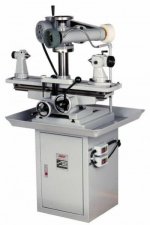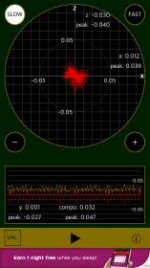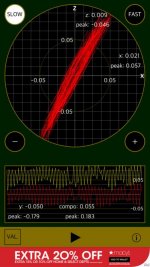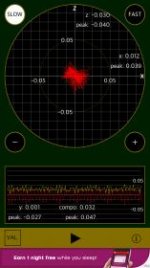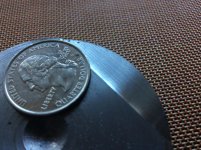dgfoster
Diamond
- Joined
- Jun 14, 2008
- Location
- Bellingham, WA
I imagine this method is not new, but it is new to me and has proved useful and could be used for other wheels besides grinding wheels.*
I think the pictures pretty much tell the story of what I made. One tool that really help figure out weight placement was a free iPhone app (Vibroscopelite) that allows the user to quantify vibration by just putting the phone in contact with the spindle housing. That allowed me to try SHCS's in various positions around the wheel measure resulting vibration. It was not that tedious to virtually eliminate vibration in the wheel; see screen shots of the app showing relatively large deflections vs. the "bullseye" pattern that measured vibration that was barely palpable to touch when the wheel was balanced. These images will be in my second post.
I found that the SHCS's by themselves did not have quite enough mass to balance the wheel, so I made the steel segments shown to augment the screws. The 2-hole segments are the same weight as two SHCS's and the 3-holes equal 3 screws.
* Background info that not everyone may care to read: The problem I was experiencing was vibration in my tool and cutter grinder when using various grinding wheels particularly a 7" Type1 wheel. The vibration caused some surface finish problems when I was grinding tapers for a "tuned up" ER collet spindle I was making.
My vintage Enco T+C Grinder is very versatile, but the cost of that versatility is structural flexibility (springiness) of the machine when compared to the relatively stiff structure of my Harig surface grinder. The need for wheel balancing on a surface grinder has been much discussed and I think the consensus is that it is not usually needed. And on the T+C grinder for just grinding a lathe cutter or other simple cutting tool, vibration is probably not a practical concern.
When I bought the T+C grinder there were a number of vibration sources including a single phase motor, pulleys not concentric, v-belt drive, and spindle that was full 11thou non-concentric. I replaced the v-belt with a flat urethane belt, turned the spindle between centers, and installed a 3-phase motor. Each upgrade improved performance, but the wheel-induced vibration seemed insurmountable until a friend pointed out the vibration apps available for smartphones. That app is very easy to use and makes quantitative what would otherwise be guesswork. BTW, this was a brand new Norton wheel.
Added later: the SHCS size was 8-32 ---someone asked. They weighed 2 grams each.
:
I think the pictures pretty much tell the story of what I made. One tool that really help figure out weight placement was a free iPhone app (Vibroscopelite) that allows the user to quantify vibration by just putting the phone in contact with the spindle housing. That allowed me to try SHCS's in various positions around the wheel measure resulting vibration. It was not that tedious to virtually eliminate vibration in the wheel; see screen shots of the app showing relatively large deflections vs. the "bullseye" pattern that measured vibration that was barely palpable to touch when the wheel was balanced. These images will be in my second post.
I found that the SHCS's by themselves did not have quite enough mass to balance the wheel, so I made the steel segments shown to augment the screws. The 2-hole segments are the same weight as two SHCS's and the 3-holes equal 3 screws.
* Background info that not everyone may care to read: The problem I was experiencing was vibration in my tool and cutter grinder when using various grinding wheels particularly a 7" Type1 wheel. The vibration caused some surface finish problems when I was grinding tapers for a "tuned up" ER collet spindle I was making.
My vintage Enco T+C Grinder is very versatile, but the cost of that versatility is structural flexibility (springiness) of the machine when compared to the relatively stiff structure of my Harig surface grinder. The need for wheel balancing on a surface grinder has been much discussed and I think the consensus is that it is not usually needed. And on the T+C grinder for just grinding a lathe cutter or other simple cutting tool, vibration is probably not a practical concern.
When I bought the T+C grinder there were a number of vibration sources including a single phase motor, pulleys not concentric, v-belt drive, and spindle that was full 11thou non-concentric. I replaced the v-belt with a flat urethane belt, turned the spindle between centers, and installed a 3-phase motor. Each upgrade improved performance, but the wheel-induced vibration seemed insurmountable until a friend pointed out the vibration apps available for smartphones. That app is very easy to use and makes quantitative what would otherwise be guesswork. BTW, this was a brand new Norton wheel.
Added later: the SHCS size was 8-32 ---someone asked. They weighed 2 grams each.
:
Attachments
Last edited:


